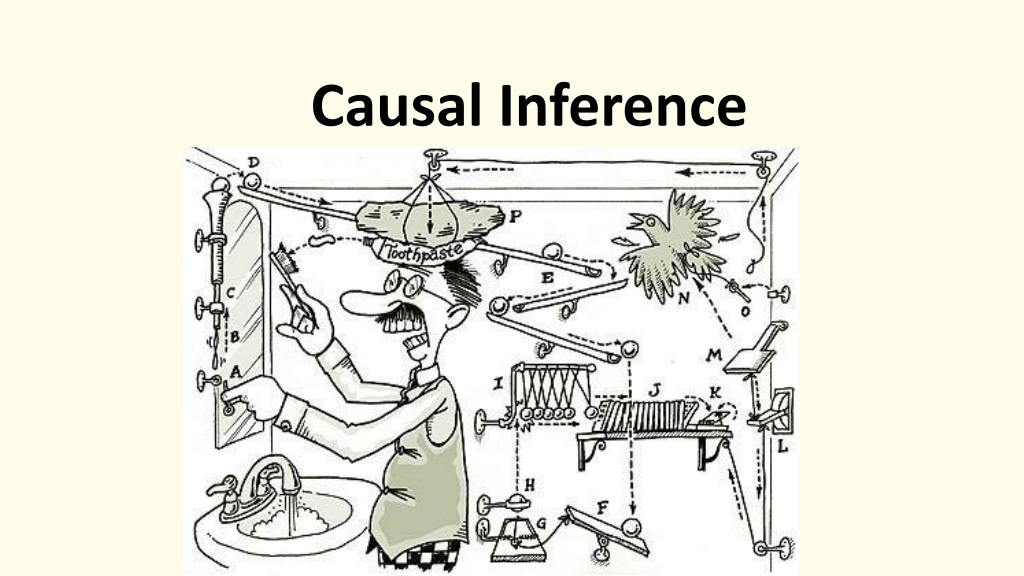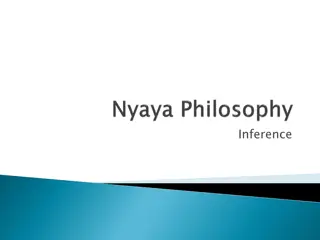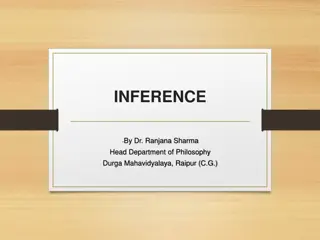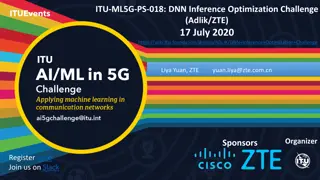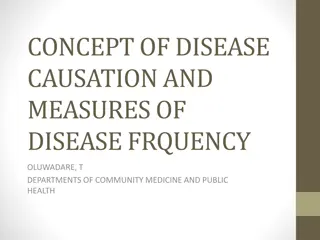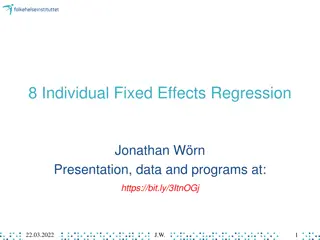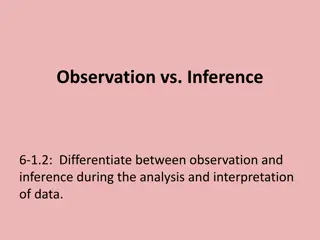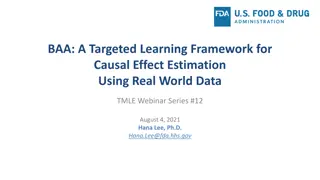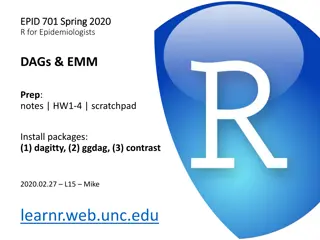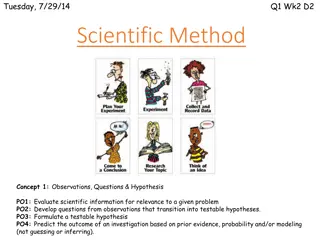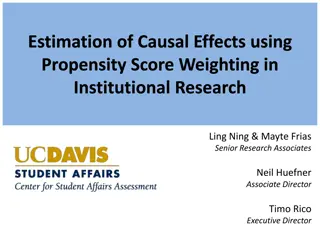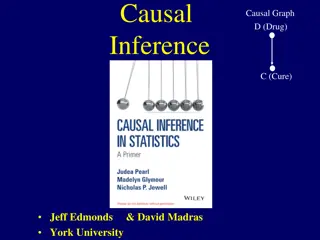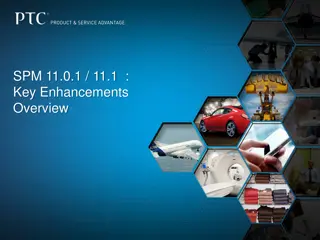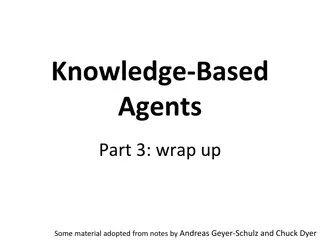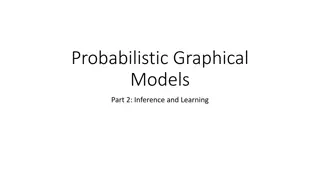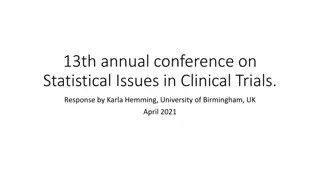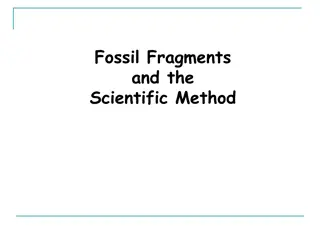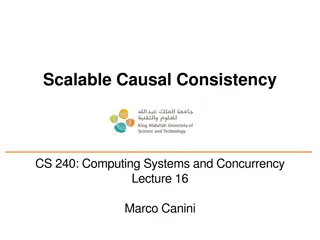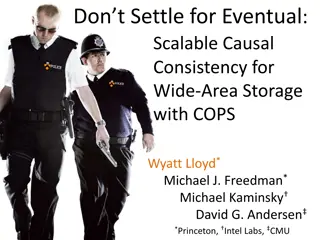Causal Inference and Scientific Goals
Download Presentation

Please find below an Image/Link to download the presentation.
The content on the website is provided AS IS for your information and personal use only. It may not be sold, licensed, or shared on other websites without obtaining consent from the author.If you encounter any issues during the download, it is possible that the publisher has removed the file from their server.
You are allowed to download the files provided on this website for personal or commercial use, subject to the condition that they are used lawfully. All files are the property of their respective owners.
The content on the website is provided AS IS for your information and personal use only. It may not be sold, licensed, or shared on other websites without obtaining consent from the author.
E N D
Presentation Transcript
Goals of Science and Links Between Them Causal Pattern Recognition Understanding Prediction & Forecasting Mechanistic Understanding All are valid and useful in particular contexts What are YOU seeking to do?
What is your question? Is it fundamentally causal? Or not?
Do You Need to be Doing Causal Inference? No! Not all studies will provide causal links between different variables of interest If the study goal is predictive or descriptive rather than causal, this might not be needed But We cannot hope to understand the world without developing an understanding of causal associations Indeed Understanding the clockwork machinery of the universe is an end goal of science one which we can never achieve, but strive for!
Building an Understanding of Our System 1. Introduction to Causal Thinking and Potential Outcomes 2. Causal Diagrams 3. Using our Causal Diagrams: Conditional Independence Backdoors and Frontdoors Counterfactual Thinking
The Classic Example Used to Dissuade us from Causal Thinking Church of the Flying Spaghetti Monster
What is Causal Thinking? Do waves drive biodiversity of invertebrates? POTENTIAL OUTCOMES Treated Di = 1 Y1i Unit Yi Untreated Di =0 Y0i
If we Only Observed Di = 1, Y0i is Counterfactual and vice-versa POTENTIAL OUTCOMES Treated Di = 1 Y1i Unit Yi Untreated Di =0 Y0i
What we Want to Know: The Potential Outcomes Framework Di = 1 Average Treatment Effect Y1i ATE = E[Y1i - Y0i]? Di = 0 BUT we CANNOT observe both Y1i and Y0i Y0i Neyman-Rubin Framework, see Holland 1986 JSA
What We Hope For Unit Y | D = 0 Y | D = 1 Y1i Y01 D A 3 4 1 1 B 6 7 1 1 C 3 4 1 1 D 2 3 1 1 E 5 6 1 0 F 1 2 1 0 G 6 7 1 0 H 9 10 1 0 ATE = E[Y1i Y0i] = E[Y1i] E[Y0i] = 1
What We Have Unit Y | D = 0 Y | D = 1 D A 4 1 B 7 1 C 4 1 D 3 1 E 5 0 F 1 0 G 6 0 H 9 0 ATE = E[Y1 Y0] = E [Y1] E[Y0] = 4.5 5.25 = -0.75 WAIT, WHAT?!?!?!?!?!?!
Treatment Effects in a Partially Observed World Di = 1 Y1i Difference in means = ATE + Selection Bias + Treatment Heterogeneity Bias Di = 0 Y0i
Selection Bias: Unequal Representation Units from D = 1 Differences in units between treated and untreated that create bias Can be that units are different or have different other external forces influencing them Units from D = 0 We get around this with experimental or statistical design controls
Treatment Heterogeneity Bias Applied Treatment Units from D = 1 Units in different treatment groups responded in different ways Can adjust for with experimental or statistical design control If we Had Applied Treatment Units from D = 0
What are Our Potential Enemies and Solutions for Potential Outcomes? We must find ways to parcel out selection bias and treatment heterogeneity in experiments We must find ways to adjust or control for selection bias and treatment heterogeneity in observations We must imagine counterfactual outcomes But HOW do we know what to adjust and control for?
Building an Understanding of Our System 1. Introduction to Causal Thinking 2. Causal Diagrams 3. Using our Causal Diagrams: Conditional Independence Backdoors and Frontdoors Counterfactual Thinking
The Core of Causal Inference what you want to evaluate Cause Effect In your research, what is your primary cause and effect of interest?
Directed Acyclic Graphs as a Means of Describing the World AKA path diagram, AKA DAG
Directed Acyclic Graphs as a Means of Describing the World Boxes represent OBSERVED variables
Directed Acyclic Graphs as a Means of Describing the World Directed Arrows show flow of causality (information)
Exogenous Drivers of a System Exogenous variable = ultimate independent variable, predictor, unexplained x1
Endogenous Variables are Inside of a System Exogenous variable Endogenous variable = dependent variable, response x1 y2 y1 Note: You might not be interested in an exogenous variable, or connection between pairs of variables, but you cannot design a study without understanding a system.
Mediators are Endogenous Variables that Can Also Be Predictors Exogenous variable Endogenous variable x1 y2 y1 Endogenous Mediator Variable = Endogenous variable that drives other endogenous variables Often we are interested in a mediator variable but we cannot assess its importance without the exogenous variable
Direct Effects Have No Mediators Direct Effect x1 y2 y1 This does not mean there are not other mediators between x1 and y2, but, those mediators are not influenced by anything else in the system.
Indirect Effects Flow Through a Mediators Direct Effect x1 y2 y1 Indirect Effect If we do not measure y1, we can only assess the TOTAL EFFECT of x1 on y2 which might be 0, but doesn t mean there is no causal link!
Unobserved Variables are Error or Things We Have Not Measured Unobserved Latent Variable Everything else affecting y2 e2 e2 x1 y2 y1 Unobserved Latent Variable Everything else affecting y1 Note: unless something wild is going on with error, we often don t draw it. e1 e1
There Can Be Connections Between Unobserved Variables x3 x1 y2 y1 If we do not consider these, we *can* produce invalid inferences x2
You Can Have Multiple Unobserved Variables: Random v. Systematic Error e2 x3 x1 y2 Knowing the structure of your system, what you have, and what you have not measured is key y1 x2 e1 x4
Interaction Effects: Moderators x1 y1 e1 x2 OR x1 x1*x2 y1 e1 x2
You Can Have an Uncertain of Unanalyzed Correlation Between Variables Unexplained correlation x1 y1 x2 e1
Really This Represents a Correlation Between Unexplained Variances 1 d1 x1 y1 2 d1 x2 e1
Could be Due to a Shared Driver 1 d1 x1 d3 y1 2 d1 x2 e1
Could Be Due to a Directed Relationship 1 d1 x1 y1 2 d1 x2 e1 If correlation is between exogenous variables, we don t care. If endogenous, we need to consider *why* as it can affect modeling choices and experimental design.
Why All of this Worry About Structure of a Whole System? x1 y2 y1 Is it possible to assess the causal relationship between y1 and y2 if you do not know x1? What can you say about any measured relationship between y1 and y2 if x1 varies, but is unmeasured?
Draw Your System Start with what is the variable you are ultimately interested in. What influences that variable DIRECTLY? What things influence those variables? Note what you have/can measure and what you cannot.
Building an Understanding of Our System 1. Introduction to Causal Thinking 2. Anatomy of Causal Diagrams 3. Using our Causal Diagrams: Conditional Independence Backdoors and Frontdoors Counterfactual Thinking
What Is It Good For? We can test our intuition by examining things that do not connect x1 We cannot take apart our system without imagining what would happen if something changes. We can begin to understand what we must grapple with to tease apart the Gordian knot of Simpson s Paradox and confounders y2 y1
So Lets Draw a DAG: Where we Start Waves Invertebrates
But there are Mediators Waves Kelp Algae Invertebrates
So Waves are Conditionally Independent of Invertebrates Waves Kelp Algae Invertebrates
Conditional Independence: The Hard Causal Claim y1 x y3 y2 These two relationships are declared to be non-existent This is a hard causal claim Is it real? How do we assess?
Quick Note: Nonlinearities Conditional indepdence generally excludes non- linear components (interactions) x1 y1 y2 x2 1. x1 y2 | (y1) 2. x2 y2 | (y1) 3. x1 * x2 y2 | (y1)
What claims of conditional independence do *you* have involving your response of interest? (and are they plausible?)
Conditional Independence (Directed Separation) Concept from Graph Theory y1 Two nodes are d- separated if they are conditionally independent e.g., the effect of x on y3 is zero conditioning on the influences of y1and y2 x y3 y2 x y3 | y1, y2
What does Conditional Independence Mean Here? Wave -> Invert Analyses CANNOT include Kelp and Algae It would only show conditional independence Waves Sampling must cover a wide range of kelp and algae Otherwise, we would miss the wave -> invert relationship Kelp Algae Invertebrates Waves Inverts | Kelp, Algae
What does Conditional Independence Mean Here? If you tried to look at the relationship between kelp and algae, conditioned on invertebrates, you d induce conditional dependence Waves Any analysis of kelp on algae must include waves as a conditioning variable Otherwise, waves would be a confounding variable Kelp Algae Invertebrates Kelp Algae | Waves
Building an Understanding of Our System 1. Introduction to Causal Thinking 2. Anatomy of Causal Diagrams 3. Using our Causal Diagrams: Conditional Independence Confounding, Backdoors, and Frontdoors Counterfactual Thinking
Confounding Variables Any analysis of kelp on algae must include waves as a conditioning variable Otherwise, waves would be a confounding variable Waves Kelp Algae Invertebrates Kelp Algae | Waves
